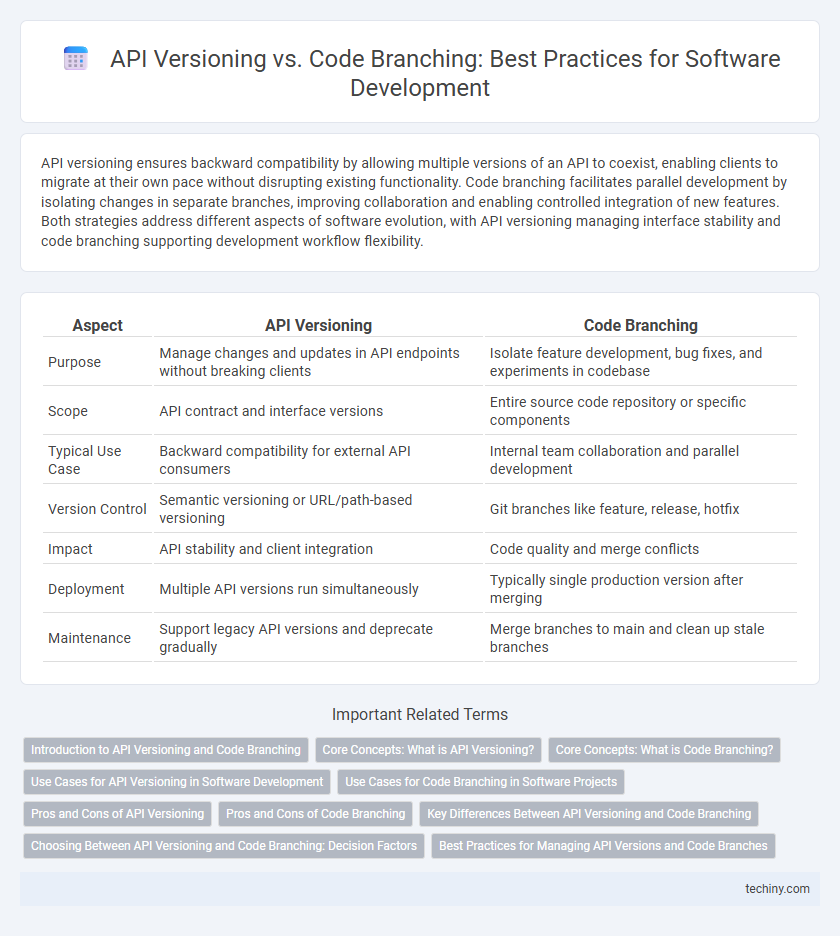API versioning ensures backward compatibility by allowing multiple versions of an API to coexist, enabling clients to migrate at their own pace without disrupting existing functionality. Code branching facilitates parallel development by isolating changes in separate branches, improving collaboration and enabling controlled integration of new features. Both strategies address different aspects of software evolution, with API versioning managing interface stability and code branching supporting development workflow flexibility.
Table of Comparison
| Aspect | API Versioning | Code Branching |
|---|---|---|
| Purpose | Manage changes and updates in API endpoints without breaking clients | Isolate feature development, bug fixes, and experiments in codebase |
| Scope | API contract and interface versions | Entire source code repository or specific components |
| Typical Use Case | Backward compatibility for external API consumers | Internal team collaboration and parallel development |
| Version Control | Semantic versioning or URL/path-based versioning | Git branches like feature, release, hotfix |
| Impact | API stability and client integration | Code quality and merge conflicts |
| Deployment | Multiple API versions run simultaneously | Typically single production version after merging |
| Maintenance | Support legacy API versions and deprecate gradually | Merge branches to main and clean up stale branches |
Introduction to API Versioning and Code Branching
API versioning manages changes in software interfaces by maintaining multiple API versions to ensure backward compatibility and smooth client transitions. Code branching in software development enables simultaneous work on features, bug fixes, or experiments without affecting the main codebase, using version control systems like Git. Both strategies streamline development workflows but target different challenges: API versioning addresses external interface changes, whereas code branching handles parallel internal development.
Core Concepts: What is API Versioning?
API versioning is a strategy to manage changes and updates to an application programming interface without disrupting existing clients by maintaining multiple versions concurrently. It enables developers to introduce new features, fix bugs, or improve functionality while preserving backward compatibility. Effective API versioning ensures smooth integration, consistent behavior, and seamless transition between different API iterations for diverse user applications.
Core Concepts: What is Code Branching?
Code branching in software development is a version control strategy that allows developers to create isolated copies of a codebase, enabling concurrent work on features, bug fixes, or experiments without affecting the main code line. Each branch acts as an independent line of development, merging back into the main branch after review and testing to ensure stability and integration. This approach supports collaborative workflows, parallel development, and controlled release management.
Use Cases for API Versioning in Software Development
API versioning is essential for maintaining backward compatibility while iterating on software features, allowing developers to introduce new functionalities without disrupting existing clients. It is particularly useful in microservices architectures where multiple clients depend on stable API contracts, enabling parallel support for legacy and updated endpoints. API versioning supports gradual migration and seamless integration across diverse platforms, reducing the risks associated with breaking changes in production environments.
Use Cases for Code Branching in Software Projects
Code branching in software development is primarily used to enable parallel development, allowing teams to work on new features, bug fixes, or experiments independently without affecting the main codebase. It supports continuous integration and continuous deployment (CI/CD) workflows by isolating changes until they are fully tested and approved, minimizing risks of introducing errors. Branching strategies like GitFlow or feature branching improve collaboration and release management by organizing development efforts around specific tasks or release cycles.
Pros and Cons of API Versioning
API versioning enables backward compatibility, allowing developers to release updates without disrupting existing clients, which reduces integration conflicts and enhances user experience. However, managing multiple API versions increases complexity, requires additional documentation, and can lead to maintenance overhead for deprecated versions. This contrasts with code branching, where feature isolation occurs in the source code but does not inherently guarantee stable interface consistency for external consumers.
Pros and Cons of Code Branching
Code branching enables parallel development by allowing multiple feature or bug fix branches, which enhances team collaboration and reduces integration conflicts. However, it may lead to complex merge processes, increased risk of code divergence, and challenges in maintaining synchronization across branches. Effective branch management strategies and merge tools are essential to mitigate these risks and ensure smooth integration workflows.
Key Differences Between API Versioning and Code Branching
API versioning manages changes in interfaces to ensure backward compatibility for external clients, enabling multiple versions to coexist and evolve independently. Code branching isolates development streams within the same repository, supporting parallel feature work, bug fixes, or experiments without impacting the main codebase. While API versioning controls contract stability across deployments, code branching organizes internal development workflow and code integration.
Choosing Between API Versioning and Code Branching: Decision Factors
Choosing between API versioning and code branching hinges on factors such as deployment frequency, backward compatibility requirements, and team collaboration dynamics. API versioning suits scenarios demanding stable interfaces for external clients, enabling simultaneous support for multiple versions without altering live codebases. Code branching excels in internal development workflows, allowing parallel feature development but can complicate release processes and impact client integration consistency.
Best Practices for Managing API Versions and Code Branches
Effective API versioning involves using clear, consistent version identifiers such as semantic versioning (e.g., v1.0.0) embedded in URLs or headers to manage backward compatibility and enable seamless client updates. Code branching strategies like GitFlow or trunk-based development help isolate new features, bug fixes, and experiments without disrupting the main codebase, facilitating efficient collaboration and release management. Combining systematic API versioning with disciplined branching practices ensures stable releases, easy rollback options, and scalable development workflows.
API Versioning vs Code Branching Infographic

 techiny.com
techiny.com